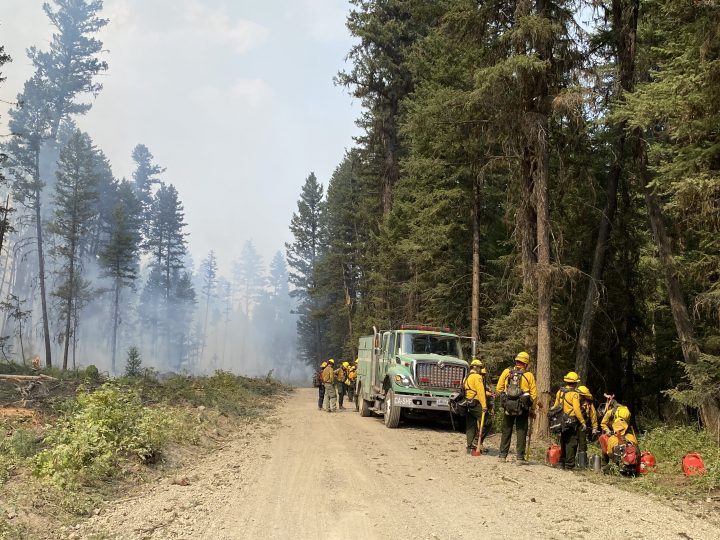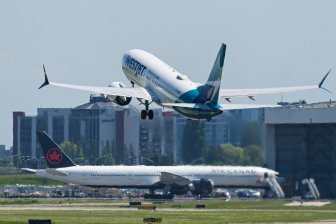Raging flames, thick smoke, intense heat and rugged terrain. Firefighters across Canada are putting their lives at risk every day as they continue to grapple with a record wildfire season this year.

At least four firefighters have died while on duty in Canada in recent weeks, bringing into sharp focus the inherent dangers of the job in a rapidly changing environment.
“The impact has just been unbearable for some,” said Ken McMullen, president of the Canadian Association of Fire Chiefs (CAFC).
“This fire season in its entirety has been just one that we’ve never seen before and now to consider, we’ve lost four precious lives in the fight, it really takes a toll on everybody,” he told Global News in an interview.
Another death in British Columbia was reported over the weekend, when a 25-year-old wildland firefighter from Ontario was fatally injured while helping battle the largest forest fire in B.C.’s history.
Tributes have been pouring in for Zachery Freeman Muise, a Waterford, Ont., native, who was working in a remote area north of Fort St. John on Friday when the UTV he was riding rolled over a steep drop on a gravel road.

The latest fatality follows three other firefighters’ deaths last month in B.C., Alberta and the Northwest Territories.
On July 13, 19-year-old Devyn Gale died while combatting a wildfire near Revelstoke, B.C., after she was struck by a falling tree.
On July 15, 25-year-old Adam Yeadon died while fighting a blaze near Fort Liard, a hamlet in the Northwest Territories north of the British Columbia boundary.
Then, on July 19, 41-year-old Ryan Gould died near Haig Lake 140 kilometres northeast of Peace River, Alta., when his helicopter crashed while fighting another fire.
It has been an extremely challenging wildfire season for Canada that has seen soldiers, volunteers and hundreds of firefighters from other countries join the fight amid a staffing crunch and recruitment challenges for their ranks.
Crews from the United States and Mexico are helping fight the Rossmore fire – one of the largest blazes burning in B.C. currently. Global News was given exclusive access this week to the front lines, 10 kilometres south of the city of Kamloops.
“We’re really being put to the test,” said Michael Piper of the U.S. Department of Agriculture Forest Service, who is part of a five-person engine crew from California.
Two Griffin helicopters and 17 military members from Alberta are also supporting the B.C. crews fighting the Rossmore flames.
“Until you see it from the air, you don’t really get an appreciation for just how rugged the terrain is out here,” said Alex McKee, a Canadian Armed Forces pilot and tactical aviation detachment commander.
What are the safety concerns for firefighters?
Wildland firefighting is a physically demanding job with many “inherent dangers,” which is why a lot of planning, communication and training goes into the response effort, says Christie Tucker, wildfire information manager for Alberta Wildfire.
The days can be long and hard.
Firefighters typically work for a stretch of two weeks at a time, which can be exhausting, Tucker said.
“They’re often sleeping in camps, they are living rough a lot of the time and getting up fairly early in the morning and sometimes working into the evening,” she told Global News.
Not only are firefighters dealing with an active fire situation, but they also have to cope with smoke, rough terrain and wildlife, Tucker says.
There is also the danger of falling trees if the roots have been burned out.
“There are safety issues at every point in being a wildland firefighter.”
Some common injuries to firefighters are broken bones, cuts, scrapes, bruises, strains and sprains.
“We see a lot of blistering, a lot of skin irritations just from the equipment that we’re wearing,” said McMullen.
The longer the season drags on and fatigue sets in, the greater the likelihood of getting injured, he added.
Firefighting crews are also expected to use different kinds of equipment and know how to safely work on aircraft and trucks.
In B.C., crews tackling the Rossmore blaze are using machetes to keep the flames out of the tree canopy. That technique was first introduced in the province by Mexican firefighters, officials say.

As a matter of policy, firefighters are not put in front of incredibly extreme and active wildfires so “indirect attacks” are employed, Tucker said.
In an indirect attack, “instead of being next to the fire, control lines are established at a significant distance, often hundreds or thousands of metres away from the fire’s edge,” according to the B.C. Wildfire Service.
“This is a way of boxing in the fire and directing it to a safer area for personnel and equipment,” it explains on its website.
Given the limited resources as well as the sheer number of blazes this year, an increasing number of municipal firefighters have had to work with the wildland crews, said McMullen of CAFC, which represents roughly 126,000 structural firefighters.
“There are going to be times where our structural firefighters actively fight fires in the treed areas. However, keep in mind that our equipment typically is not designed to be off-road like the equipment that’s used (by) our wildland colleagues.”

Alberta has brought in nearly 4,000 additional firefighters from across Canada and other countries for this wildfire season, which Tucker says has been a huge help to the province.
“Certainly one of the big benefits of bringing in incident management teams, bringing in firefighters from overseas, is that they give our own firefighters a much-needed chance for a rest,” she said.
As of Aug. 1, there were roughly 1,030 active fires burning across the country and more than half of those were out of control, according to the latest data from the Canadian Interagency Forest Fire Centre (CIFFC).
An unprecedented 13 million hectares of land has already been torched this year.
With the season far from over and more hot, dry weather forecast ahead, there is still dangerous work to be done.
“The risks are far from being eliminated, and we need individuals to still play their part in reducing or preventing fires from their own communities,” said McMullen.
— with files from Global News’ Neetu Garcha and The Canadian Press.







Comments